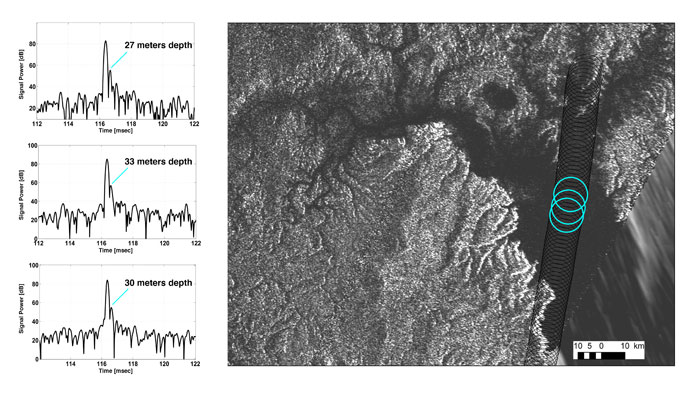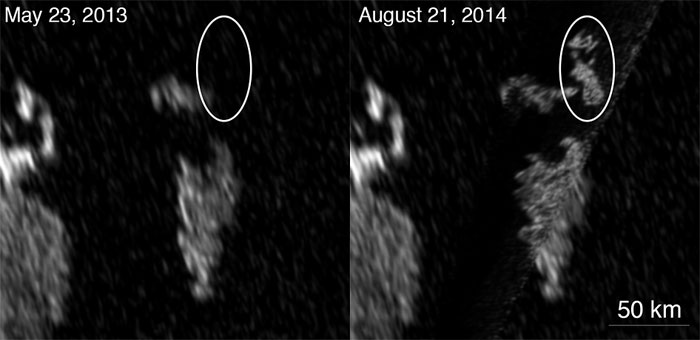.
30.09.2014

These three images, created from Cassini Synthetic Aperture Radar (SAR) data, show the appearance and evolution of a mysterious feature in Ligeia Mare, one of the largest hydrocarbon seas on Saturn's moon Titan.
Mysterious Changing Feature in Ligeia Mare
These three images, created from Cassini Synthetic Aperture Radar (SAR) data, show the appearance and evolution of a mysterious feature in Ligeia Mare, one of the largest hydrocarbon seas on Saturn's moon Titan. The views, taken during three different Cassini flybys of Titan, show that this feature was not visible in earlier radar images of the same region and its appearance changed between 2013 and 2014.
In the images, the dark areas represent the sea, which is thought to be composed of mostly methane and ethane. Most of the bright areas represent land surface above or just beneath the water line. The mysterious bright feature appears off the coast below center in the middle and right images.
The mystery feature had not been seen in preceding SAR observations of the region from 2007 to 2009. After its first appearance in early July 2013, it was not visible in observations by Cassini’s Visible and Infrared Mapping Spectrometer, obtained later in July and in September 2013. Low-resolution SAR images obtained in October 2013 also failed to recover the feature.
The SAR observation from Cassini's August 21, 2014 Titan flyby shows that the feature was still visible, although its appearance changed during the 11 months since it was last observed. The feature seems to have changed in size between the images from 2013 and 2014 -- doubling from about 30 square miles (about 75 square kilometers) to about 60 square miles (about 160 square kilometers). Ongoing analyses of these data may eliminate some of the explanations previously put forward, or reveal new clues as to what is happening in Titan’s seas.
The Cassini radar team is investigating possible origins for the feature, including surface waves, rising bubbles, floating solids, solids that are suspended just below the surface or perhaps something more exotic. Researchers suspect that the appearance of this feature could be related to changing seasons on Titan, as summer draws near in the moon's northern hemisphere. Monitoring such changes is a major goal for Cassini's current extended mission.
The upper half of the middle image uses data from the April 26, 2007 Titan flyby. That area did not receive SAR coverage during the July 10, 2013 encounter, so the earlier data was used to fill-in the scene.
.
NASA's Cassini spacecraft is monitoring the evolution of a mysterious feature in a large hydrocarbon sea on Saturn's moon Titan. The feature covers an area of about 100 square miles (260 square kilometers) in Ligeia Mare, one of the largest seas on Titan. It has now been observed twice by Cassini's radar experiment, but its appearance changed between the two apparitions.


The mysterious feature, which appears bright in radar images against the dark background of the liquid sea, was first spotted during Cassini's July 2013 Titan flyby. Previous observations showed no sign of bright features in that part of Ligeia Mare. Scientists were perplexed to find the feature had vanished when they looked again, over several months, with low-resolution radar and Cassini's infrared imager. This led some team members to suggest it might have been a transient feature. But during Cassini's flyby on August 21, 2014, the feature was again visible, and its appearance had changed during the 11 months since it was last seen.
Scientists on the radar team are confident that the feature is not an artifact, or flaw, in their data, which would have been one of the simplest explanations. They also do not see evidence that its appearance results from evaporation in the sea, as the overall shoreline of Ligeia Mare has not changed noticeably.
The team has suggested the feature could be surface waves, rising bubbles, floating solids, solids suspended just below the surface, or perhaps something more exotic.
The researchers suspect that the appearance of this feature could be related to changing seasons on Titan, as summer draws near in the moon's northern hemisphere. Monitoring such changes is a major goal for Cassini's current extended mission.
“Science loves a mystery, and with this enigmatic feature, we have a thrilling example of ongoing change on Titan," said Stephen Wall, the deputy team lead of Cassini's radar team, based at NASA's Jet Propulsion Laboratory in Pasadena, California. "We’re hopeful that we’ll be able to continue watching the changes unfold and gain insights about what’s going on in that alien sea.”
Quelle: NASA
.
Update: 11.11.2014
.
Cassini Sails into New Ocean Adventures on Titan
.
NASA's Cassini mission continues its adventures in extraterrestrial oceanography with new findings about the hydrocarbon seas on Saturn's moon Titan. During a flyby in August, the spacecraft sounded the depths near the mouth of a flooded river valley and observed new, bright features in the seas that might be related to the mysterious feature that researchers dubbed the "magic island."
The findings are being presented this week at the Division for Planetary Sciences Meeting of the American Astronomical Society held in Tucson, Arizona.
To the delight of Cassini scientists, two new bright features appeared in Titan’s largest sea, Kraken Mare, during the August 21 flyby. In contrast to a previously reported bright, mystery feature in another of Titan's large seas, Ligeia Mare, the new features in Kraken Mare were observed in both radar data and images from Cassini's Visible and Infrared Mapping Spectrometer (VIMS). Having observations at two different wavelengths provides researchers with important clues to the nature of these enigmatic objects
The VIMS data suggest the new features might have similarities to places in and around the seas that the Cassini team has interpreted as waves or wet ground. The observations support two of the possible explanations the team thinks are most likely -- that the features might be waves or floating debris.
Unfortunately for mystery lovers, the August Titan flyby marked the final opportunity for Cassini's radar to observe Kraken Mare. However, the spacecraft is scheduled to observe the original "magic island" feature in Ligeia Mare once more, in January 2015.
The August Titan flyby also included a segment designed to collect altimetry (or height) data, using the spacecraft's radar instrument along a 120-mile (200-kilometer) shore-to-shore track of Kraken Mare. For a 25-mile (40-kilometer) segment of this data along the sea's eastern shoreline, Cassini's radar beam bounced off the sea bottom and back to the spacecraft, revealing the sea's depth in that area. This region, which is near the mouth of a large, flooded river valley, showed depths of 66 to 115 feet (20 to 35 meters). Cassini will perform this experiment one last time in January 2015, to try to measure the depth of Punga Mare. Punga Mare is the smallest of three large seas in Titan's far north, and the only sea whose depth has not been observed by Cassini.
Scientists think that, for the areas in which Cassini did not observe a radar echo from the seafloor, Kraken Mare might be too deep for the radar beam to penetrate. Alternatively, the signal over this region might simply have been absorbed by the liquid, which is mostly methane and ethane. The altimetry data for the area in and around Kraken Mare also showed relatively steep slopes leading down to the sea, which also suggests the Kraken Mare might indeed be quite deep.
The Cassini-Huygens mission is a cooperative project of NASA, the European Space Agency and the Italian Space Agency. JPL, a division of the California Institute of Technology, Pasadena, manages the mission for NASA's Science Mission Directorate in Washington. The VIMS team is based at the University of Arizona in Tucson. The radar instrument was built by JPL and the Italian Space Agency, working with team members from the US and several European countries..
.

Cassini radar data reveal the depth of a liquid methane/ethane sea on Saturn's moon Titan near the mouth of a large, flooded river valley.
Image Credit: NASA/JPL-Caltech/ASI/Cornell
.

Bright Feature Appears in Titan's Kraken Mare
Two Synthetic Aperture Radar (SAR) images from the radar experiment on NASA's Cassini spacecraft show that, between May 2013 and August 2014, a bright feature appeared in Kraken Mare, the largest hydrocarbon sea on Saturn's moon Titan. Researchers think the bright feature is likely representative of something on the hydrocarbon sea's surface, such as waves or floating debris.
A similar feature appeared in Ligea Mare, another Titan sea, and was seen to evolve in appearance between 2013 and 2014 (see PIA18430).
The image at left was taken on May 23, 2013 at an incidence angle of 56 degrees; the image at right was taken on Aug. 21, 2014 at an incidence angle of 5 degrees. Incidence angle refers to the angle at which the radar beam strikes the surface.
The Cassini-Huygens mission is a cooperative project of NASA, the European Space Agency and the Italian Space Agency. NASA's Jet Propulsion Laboratory, a division of the California Institute of Technology in Pasadena, manages the mission for NASA's Science Mission Directorate, Washington, DC. The Cassini orbiter was designed, developed and assembled at JPL. The radar instrument was built by JPL and the Italian Space Agency, working with team members from the United States and several European countries.
Quelle: NASA
5623 Views
